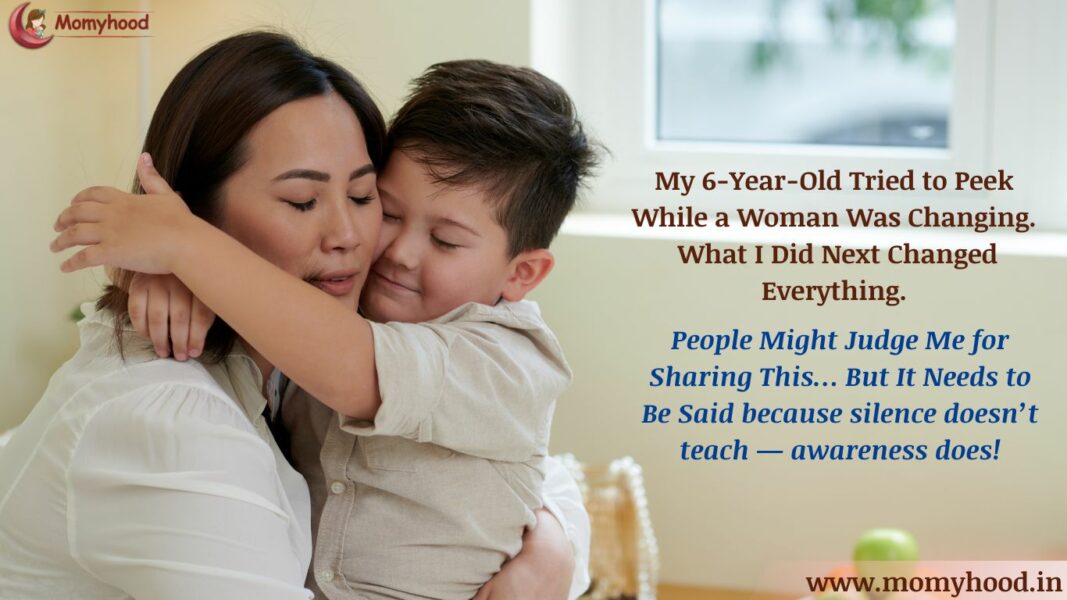A few weeks ago, I found myself in a situation I wasn’t expecting — the kind that makes you stop, feel a mix of emotions, and think deeply about the way you’re raising your child.
As a mother, I’ve always tried to create a safe, open, and respectful space for my 6-year-old son. But parenting has a way of throwing curveballs — especially when you think “not my child.” And this particular curveball forced me into teaching children about privacy in a way I never anticipated.
So here’s what happened!
Why Teaching Children About Privacy Matters More Than Ever
In today’s world, teaching children about privacy isn’t optional—it’s essential. With increased exposure to media, earlier physical development, and changing family dynamics, children are processing information about bodies and boundaries younger than ever before.
As parents, we often focus on stranger danger or online safety. But teaching children about privacy starts at home—with everyday moments, casual interactions, and the subtle messages we send through our own behavior.
I learned this the hard way.
The First Red Flag
I noticed something unusual about my son’s behavior.
📣 Loved what you read? Want to go deeper into conscious parenting? ✨ The Power of Manifestation in Parenting is now available — A soulful guide packed with real-life tools like affirmations, energy shifts, and sleep talk that I personally use with my son, Hitarth. 💛 Start your journey toward calmer, connected parenting today. 🎉 Launch Offer: Only ₹99 (limited-time price!) 📲 Instant download. No waiting. 👉 Grab your copy now!.
He seemed to follow his bua (aunt) when she went into her room to change her clothes. At first, I thought it was nothing — just a child being playful.
But something felt off. So I asked him casually, “Why were you going there?”
He denied. Flat out. “No Mumma, I wasn’t doing anything.”
But I could sense it — the hesitation in his tone, the avoidance in his eyes.
Eventually, with gentle insistence and a calm tone, I sat him down and asked again. This time, he lowered his eyes and admitted:
“Mumma… I just wanted to see bua changing her clothes.”
For a few seconds, my mind went blank.
And then I felt it — Anger. Shock. Disappointment.
Yes, I was angry. Very.
But I also knew — anger wouldn’t help. Shouting would only push him away, make him hide more, and fill him with shame instead of understanding.
I had to parent — not punish.
Inside, my mind was racing. Where did this come from? Why?
But I controlled my emotions and spoke to him calmly about privacy and respecting others’ space.
I thought the matter was over & he understood!
But Then… It Happened Again
A few days later, I saw him trying to peek at another woman in our home.
And trust me, I feel awful even writing this. I know how it may sound — and I know some might judge. But I’ve always promised myself I’d choose honesty over image.
This time I caught him clearly.
And I did raise my voice:
“What were you doing there now?” I asked, unable to hide my frustration.
But what followed broke my heart — he cried.
Not because he was scolded — but because he was genuinely guilty.
He said:
“Mumma please, don’t tell anyone. I’m sorry.”
That moment — I saw something shift in him. It wasn’t just a child being naughty.
It was a little boy filled with guilt and confusion.
He didn’t even know why he did it — he just knew now that it was “wrong.”
His tears weren’t fake. He was not being mischievous. He was confused, ashamed, and overwhelmed.
Related read: Teaching the Concept of Privacy to Kids
Teaching Children About Privacy: The Conversation That Changed Everything
What I Did Next – As a Mother and a Guide
This time, I knew I had to act with compassion and firmness. I held him close, wiped his tears, and looked him in the eyes.
Here’s exactly what I told him:
“Beta, I know you’re curious. And it’s okay to be curious. But we should never, ever look at anyone when they are changing their clothes.”
“Even if someone forgets to close the door — it doesn’t give us permission to look. It’s their private moment. And we respect privacy — always.”
“How would you feel if someone tried to look at you when you’re changing? You’d feel bad, right?”
He nodded. He understood.
Then I continued — and this part I wasn’t sure about, but I still said it:
“Beta, if people don’t learn this and keep doing such things when they grow up, they can get into big trouble — even with the police.”
His eyes widened.
That line hit him.
Later, I thought about it again. And yes — maybe I shouldn’t have said the “police” part.
Maybe it was too heavy for his age.
But at that moment, I needed him to understand that this isn’t “just a naughty thing.”
It has serious consequences — now and in the future.
And honestly? I don’t regret saying it.
Because sometimes, a little fear mixed with love can create a lasting understanding.
I Also Said This — To Build Trust
I ended the conversation with something that I always try to remind him:
“Beta, if there’s anything you ever feel confused about, or want to ask — come to me. I won’t scold you for asking questions. But hiding things, or doing them secretly, can hurt you and others. I’m always here to help you understand.”
He hugged me tightly.
I knew he felt safe again.
Also read: Social Media for Teens: How to Set Healthy Limits Without Backlash
The Bigger Issue: Open Doors, Innocent Eyes
In our hometown, it’s common for elderly women to change clothes with open doors — especially around children they consider “too young to understand.”
But the truth is:
Today’s children are not too young.
They observe. They internalize.
And they begin forming beliefs early — about bodies, privacy, and boundaries.
And when they constantly see this happening without any caution, they begin to believe it’s normal. That it’s okay to watch. That privacy doesn’t matter.
That’s where curiosity turns into behavior.
Then I Educated the Adults Too
I also had a conversation with the elderly women of my home — lovingly, respectfully.
I told them: “He is not too small. He watches, he notices. So please don’t change in front of him — even casually. We have to model the right habits.”
They didn’t argue. In fact, they were surprised. They had never thought of it this way — because they never had to.
But now, they understood.
5 Months Later – What Changed, and What It Taught Me
The Long-Term Impact of Teaching Children About Privacy
It’s been five months since that incident.
And honestly, I can see a huge shift in my son.
Now, he doesn’t just follow rules—he understands the why behind them. Teaching children about privacy isn’t about creating fear; it’s about building internal values that guide their choices even when no one’s watching.
Now, he doesn’t let anyone enter the room when he’s changing.
He says, “Close the door, I’m changing.”
And if we casually begin to change in front of him, even slightly, he says with full confidence:
“No Mumma, please don’t. We shouldn’t do that.”
That’s when it hit me —
He didn’t just listen to us that day.
He understood. He accepted. He made it part of his values.
And as a mother, there’s no greater reassurance than seeing your child live the lessons you taught with your whole heart.
This experience didn’t just teach him about privacy —
It reminded me that even difficult, uncomfortable conversations can lead to beautiful, lifelong learning — when they’re rooted in patience, respect, and love.
“He didn’t just hear us — he absorbed it, and now he lives it.”
Lessons I Learned (and Want to Share)
Don’t ignore red flags
Children express things through behavior. Watch, observe, ask.
Don’t shame, and don’t ignore
Your child is not “bad” — they’re learning. Curiosity is natural, but silence can turn it into secrecy or guilt. Balance love with clear guidance.
Teach empathy first
Flip the situation — “Would you like it if…?” works wonders.
Create a culture of privacy
Even if others aren’t careful, you can teach your child to respect closed doors and personal space.
Talk openly
If your child knows he can come to you without fear, he won’t hide. He’ll learn — and trust. These moments are not problems — they’re opportunities.
Educate the elders too
Changing generations need changing conversations. Don’t be afraid to correct old habits with love and awareness.
Teaching Children About Privacy: A Simple Framework for Parents
Based on my experience as both a mother and child psychologist, here’s a practical approach to teaching children about privacy:
Start Early (Ages 3-5):
- Introduce the concept of “private parts” and “private moments”
- Model closing doors when changing or using the bathroom
- Use simple language: “Everyone’s body is their own”
Build Understanding (Ages 5-7):
- Explain why privacy matters, not just what the rules are
- Use empathy: “How would you feel if…?”
- Create clear boundaries about knocking before entering rooms
Reinforce Consistently (Ages 7+):
- Discuss scenarios: what to do if someone forgets to close a door
- Talk about privacy in digital spaces too
- Keep communication open without shame
The key to teaching children about privacy is consistency—not perfection.
Common Mistakes Parents Make When Teaching Children About Privacy
Through my practice and personal experience, I’ve noticed these pitfalls:
Assuming “they’re too young to understand” Children notice and absorb far more than we realize. Teaching children about privacy should begin as soon as they can understand basic concepts.
Reacting with anger or shame This teaches them to hide, not to respect boundaries.
Being inconsistent If adults don’t model privacy, children won’t value it. Teaching children about privacy requires the whole household to participate.
Having “the talk” once and thinking it’s done Privacy education is ongoing, not a one-time conversation.
Final Thought
What my son did was not evil. It was not ‘bad’.
It was uninformed.
And that’s exactly why it became a parenting moment — a chance to teach, to shape, and to guide. Teaching children about privacy isn’t a one-time talk; it’s an ongoing journey of building awareness, respect, and boundaries.
As parents, we won’t always have perfect answers.
But if we stay open, aware, and emotionally present — we’ll know what to do when it matters.
Have you faced something like this? Let’s not stay silent. Let’s help each other grow — with honesty, not shame. 💬
Your comments and shares do more than just support our blog—they uplift the amazing moms who share their stories here. Please scroll down to the end of the page to leave your thoughts, and use the buttons just below this line to share. Your support makes a big difference!



